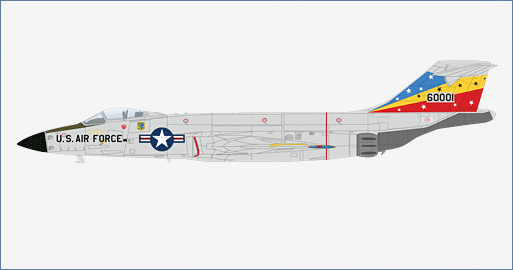Air Power Series>1:72 die-cast display model>F-101>HA9303
F-101C Voodoo "Robin Olds" 92nd TFS, 81st TFW, Bentwaters 1964

General Background
The F-101A fighter-bomber had been accepted into Tactical Air Command (TAC) service despite a number of problems. Among others, its airframe had proven to be capable of withstanding only 6.33 g (62 m/s²) maneuvers, rather than the intended 7.33 g (72 m/s²).An improved model, the F-101C, was introduced in 1957. It had a 500 lb (227 kg) heavier structure to allow 7.33-g maneuvers as well as a revised fuel system to increase the maximum flight time in afterburner.Like the F-101A, it was also fitted with an underfuselage pylon for carrying nuclear weapons, as well as two hardpoints for 450-US-gallon (1,700 L) drop tanks. A total of 47 F101Cs were produced.
Specifications :
| Role: | Supersonic fighters |
| Crew: | 1 |
| Dimensions | |
| Length : | 67 ft. 5 in. (67 ft. 11 in. RF-101G/H) |
| Wingspan : | 39 ft. 8 in. |
| Height : | 18 ft. 0 in. |
| Weight | |
| Empty : | 43,020 lbs. |
| Performance: | |
| Powerplant : | Two Pratt & Whitney J57-P-13 rated at approx. 10,200 lbs. sea level static military thrust, and at approx. 15,000 lbs. maximum thrust (with afterburner) |
| Maximum speed : | 1,070 mph/870 knots |
| Range : | 690 nm. |
| Service ceiling : | 50,300 ft. |
| Cruising speed : | 550 mph/480 knots at 35,000 ft. |
| Armament : | Three automatic firing M-39 20mm guns; two guns are on the left side of the airplane and one is located on the lower right side of the airplane; an external store can be carried on a removable pylon mounted on the underside of the fuselage; an automatic lead computing sight, coupled with a radar ranging system, is provided for accurate gun firing; bombing equipment includes the LABS (Low Altitude Bombing System) and the LADD (Low Angle Drogue Delivery) system; additional features include provisions for DIRECT (manual) bomb release (T.O 1F-101A-1) |

